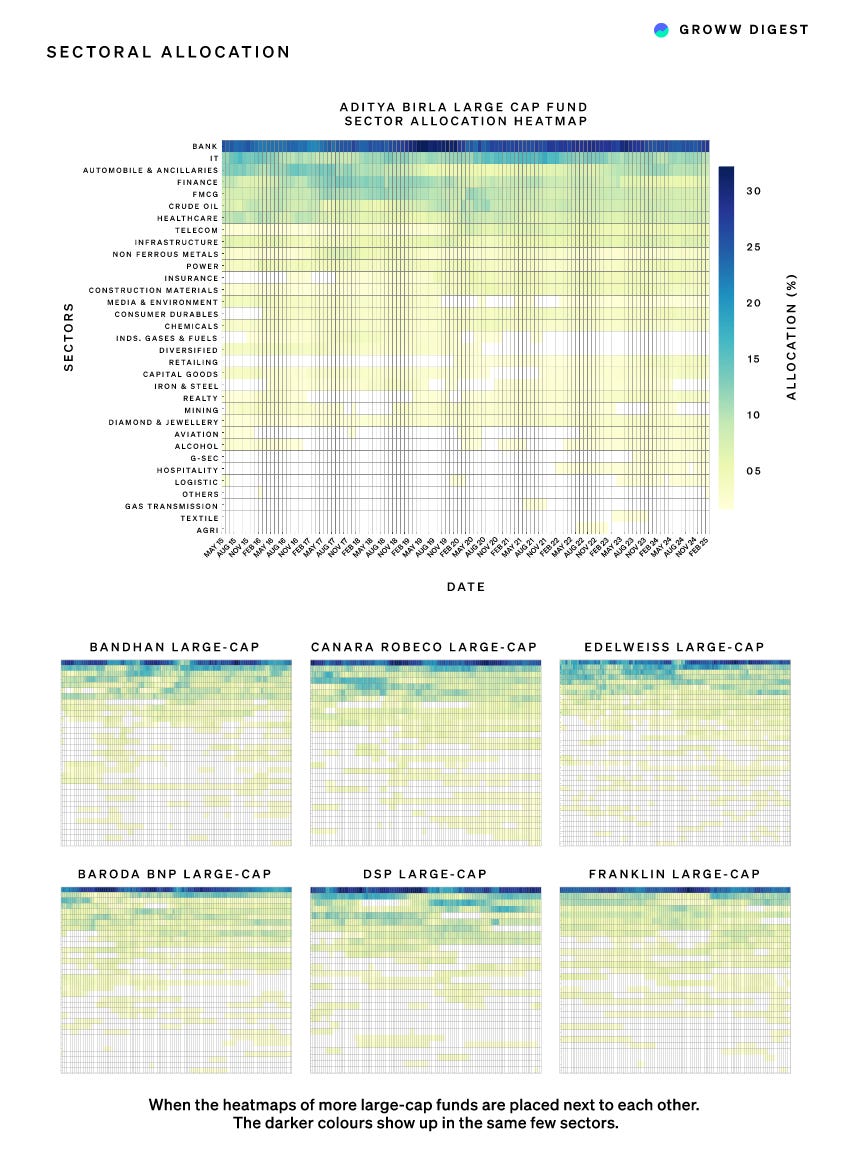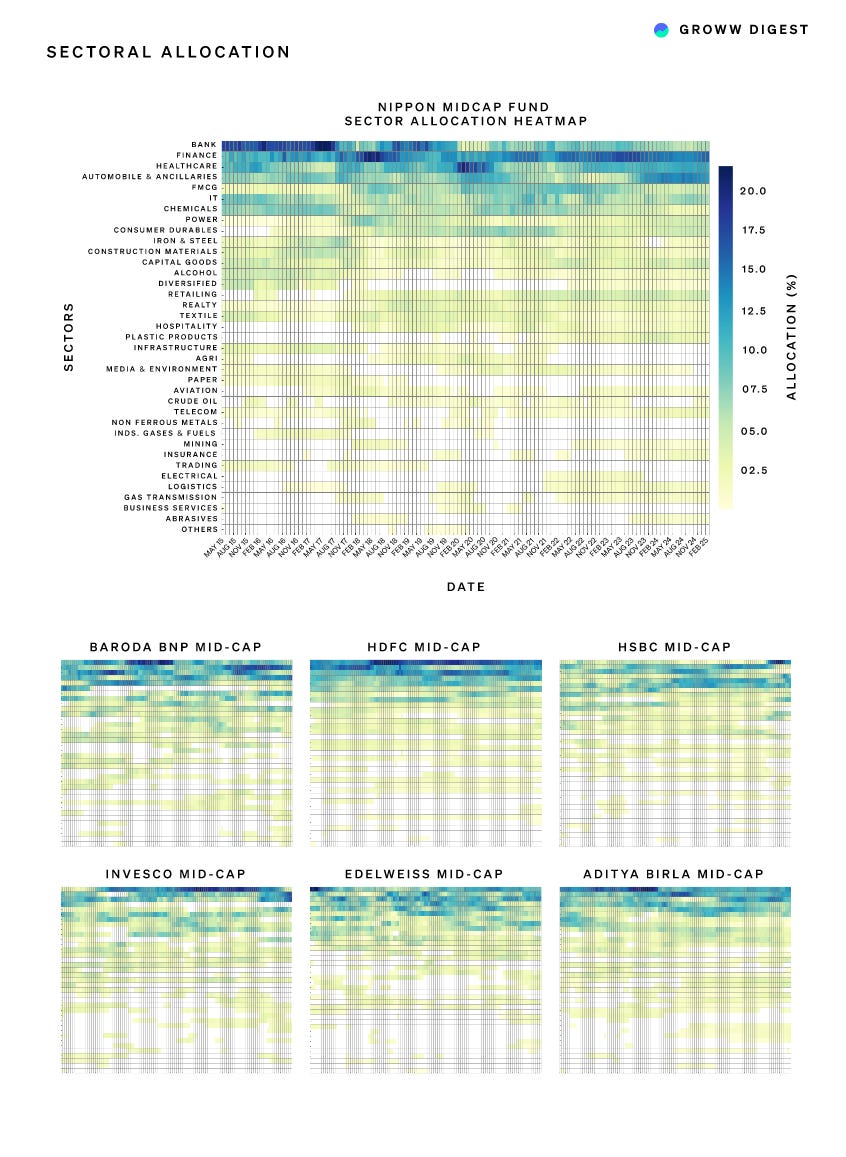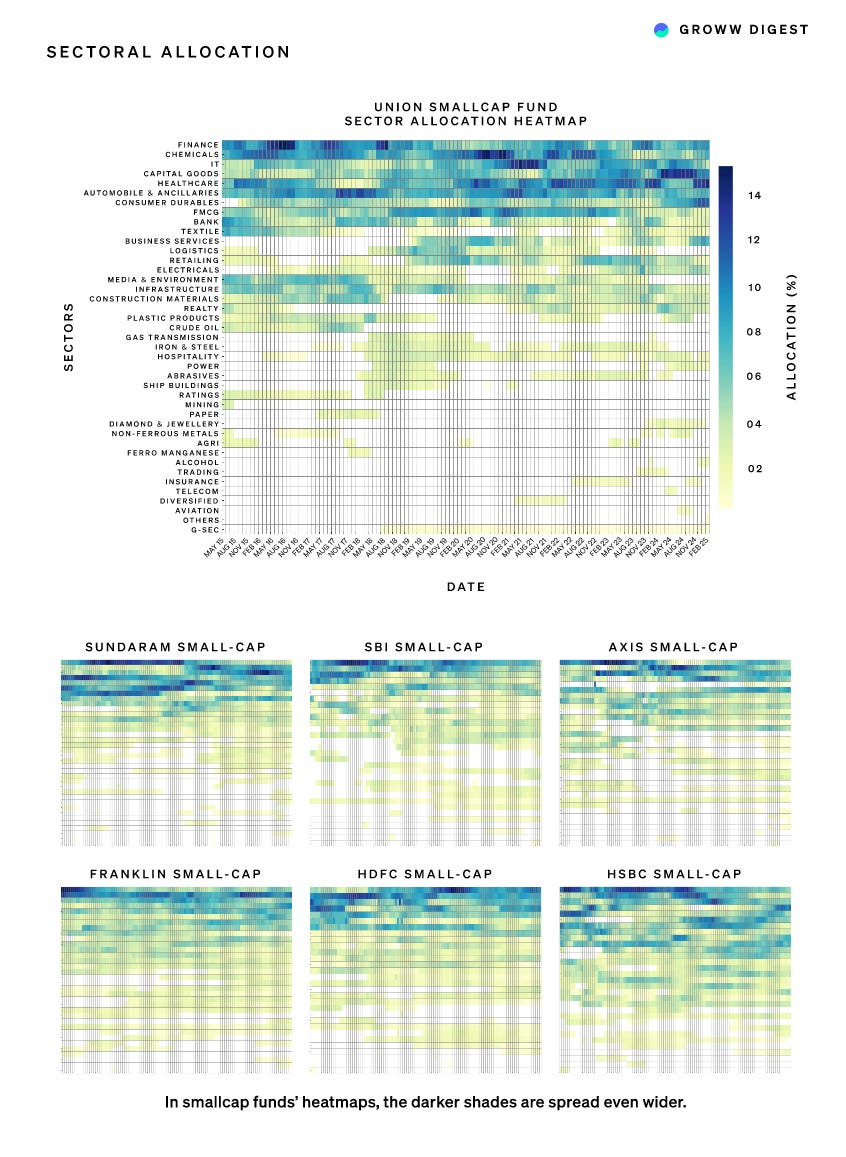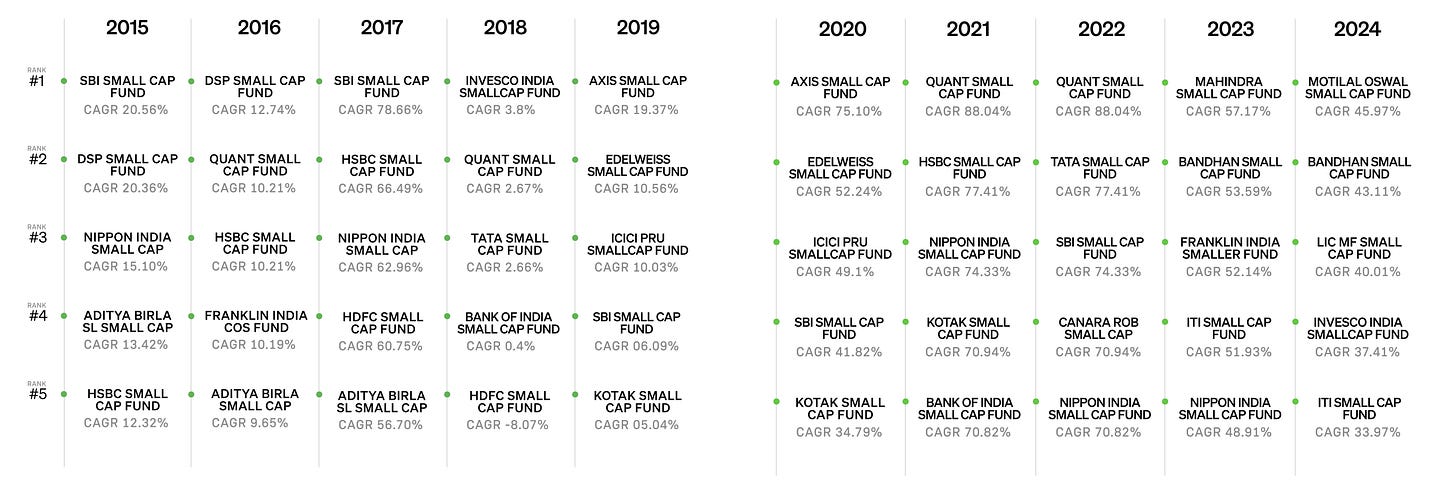Sectoral Allocation
How Mutual Funds Allocate Across Sectors — And What It Reveals About Their Strategy
When you study mutual funds across different segments — large-cap, mid-cap, and small-cap — you start noticing clear differences in how they think and invest.
The sectors they allocate their money to tell us about their nature and style of investing.
To understand this, we analyzed what percentage of their portfolios each mutual fund category allocated to different sectors/industries over the last 10 years.
A clear pattern starts to show.
When you plot a heat-map of these allocations over time, it becomes easier to spot these patterns.
Even though each fund follows its own strategy, the funds within the same segment tend to behave similarly.
You can actually see this in the depth of colour.
Large-cap funds
We observe that large-cap funds are very stable. They usually invest in a few major sectors and stick with them every year. Most large-cap funds have a high percentage of their portfolio in banking, finance and IT.
In the heat-map, this shows up clearly — you’ll see thick, dark blue horizontal bands for those sectors/industries.
These sectors form the core of almost every large-cap fund we analyzed. Even when markets change, these funds don’t shift their sector allocations quickly.
Their approach is slow and steady.
During major events like the COVID crash in 2020 or market corrections in 2022, large-cap funds did not make big changes. They increased their allocations a bit to defensive sectors like FMCG and pharma, but the overall strategy remained consistent.
Mid-cap funds
Mid-cap funds behave differently from large-cap.
They show more variation in sector choices. This can be seen in the chart where the darker shade which shows allocation are wider and more spread out, covering more sectors/industries in mid-cap.
They also tend to be more active in shifting allocations and sectors. The most common sectors mid-cap funds allocate their funds to are capital goods, finance, auto, chemicals, and healthcare. These sectors usually make up a large part of the portfolio.
Their focus is mostly on domestic themes — companies that benefit from India’s infrastructure growth, manufacturing, and consumption.
Mid-cap funds also seem to invest in sectors like textiles, agri inputs, retailing, and plastic products.
Overall, mid-cap funds are more dynamic, theme-driven, and focused on sectors tied to India’s domestic growth.
This also means that mid-cap funds’ portfolios do not always look similar. There can be big differences — unlike large-cap funds where all pof their portfolios tend to look similar.
Notice how in the heat-maps of large-cap funds, the blue-bank was almost always in the finance sector across nearly all large-cap funds; but in case of mid-cap funds, there is no clear industry that is chosen by all mid-cap funds.
Small-cap funds
Small-cap funds seem to be most active and aggressive in their allocation style.
While some core sectors appear consistently — such as capital goods, healthcare, chemicals, auto, and finance — the way small-cap funds allocate to other sectors changes frequently.
There is a high level of churn, with allocation in new sectors appearing and disappearing every few quarters.
These funds invest in a wider range of sectors. The darker shade in the heat map can be seen spread across many more sectors compared to mid-cap and large-cap funds, including many that are not commonly seen in large-cap or mid-cap funds’ portfolios.
Examples include logistics, plastic products, cables, retailing, and diagnostics.
Stocks from these sectors often get bought for short periods and then get dropped off, depending on market trends and fund manager views.
During market corrections these funds usually remain invested toward high-growth, high-volatility sectors.
Overall, small-cap funds are managed with a focus on growth and upside.
They try to beat it by a bigger margin by taking early positions in emerging sectors.
This results in higher portfolio churn, and a broader mix of sectors compared to mid-cap and large-cap funds.
Top Performers
No Fund Stays at the Top Every Year
Every investor has asked this question at some point —
“Which is the best small-cap or mid-cap fund to invest in right now?”
The answer keeps changing.
Often faster than you’d expect.
The top fund today might not even show up in the top five next year. And the one at the bottom could be back at the top in just a few quarters. The rankings are constantly reshuffling.
So, what causes this? Why can’t one fund just stay on top?
There are two big reasons behind this constant shuffle in the leaderboard — and they have to do with both the manager and the market.
The first reason is simple: fund manager skill. In the world of small and mid-cap investing, stock picking matters. A lot.
So, when a manager gets it right — finds the right companies early, bets on the right sectors, avoids weak businesses — the results can be outstanding.
And that’s the edge that active managers bring to this space. But that’s just half the story.
The second reason is the market itself.
Even the most skilled manager has to play on the same shifting ground as the overall market.
But there’s another hidden challenge — as a fund grows larger in AUM, managing that money becomes harder. What worked at Rs 5,000 crore doesn’t work the same way at Rs 30,000 crore — especially in small caps.
At a smaller size, funds can pick niche companies with limited liquidity. But as AUM grows, they often have to dilute their bets. They might need to add bigger companies just to be able to deploy capital efficiently.
When we studied fund rankings between 2014 and 2024, we found few things:
- first, no fund stays on top every year.
-Over a 10-year stretch, 6 different funds claimed the #1 position at different times.
-In total, 19 unique funds appeared in the top 5 across that decade.
That’s a lot of rotation.
It means that just because a fund did well last year doesn’t mean it will do well this year — especially in volatile categories like small- and mid-caps.
“We believe that we are currently in a golden period, which is likely to last for at least the next five years. If India is to perform well in the coming years, as we all expect, the best way to capitalize on that growth will be through mid and small caps, as their earnings growth will likely outpace that of large caps.”
-Mr. Niket Shah (Motilal Oswal AMC, CIO)






